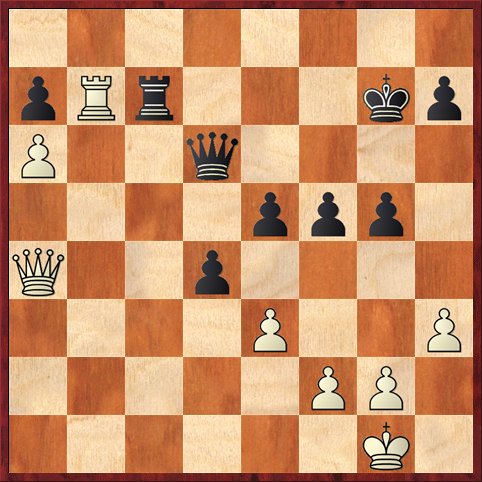Sam Shankland had a pretty disappointing performance at the U.S. Championship, as he tied for last place and had no wins in nine games. But here at the Chicago Open, he has turned it around. This round he beat Alex Lenderman to move into a tie for first with Akobian, Najer, and maybe one or two other people at 5-1. Go, Sam!
Unfortunately, I am not doing nearly as well at upholding the mantle of Bay Area chess. In my last three games, I have drawn two and lost one, all against experts, and my score now stands at 2-4. It’s an old tale of missed opportunities. In both of my draws I missed wins (time trouble being a contributing factor). The loss was just a loss. I bungled a Nimzo-Indian and suffered for the whole game.
This morning’s game was highly entertaining, even if flawed. I played against another blogger, Bill Brock. I got a good position out of the opening but then just hung a pawn for no reason. Nevertheless, I managed to stir up a little bit of trouble, and saved a draw. And that would seem to be that. However, when we analyzed the game over lunch, to see if he had any way to win, I discovered a miraculous win — not for him but for me!
Take a look at this position:
Find the miracle win for White!
First, let me tell you what I played. Brock’s last move, 35. … Qd6, set a trap that I fell right into (I only had about three minutes to make five moves). Namely, I thought I could win a pawn with 36. Rxc7+? Qxc7 37. ed, only to discover that after 37. … Qc1+ 38. Kh2 Qf4+ 39. Kg1 Qxd4, Black wins it back with a beautifully centralized queen. Nevertheless, after 40. Qc6! I managed to draw, because Black’s king is just too drafty.
Instead I should have played 36. ed! But I didn’t really see the point in playing this move order. The truly spectacular move is White’s next. After 36. … ed, White wins with 37. Qc2!!
Note that the similar idea 37. Qc4 only draws, after 37. … Rxb7 38. ab d3! and White has to give up his own pawn to stop Black’s. The ingenious point of the retreating move 37. Qc2!! is that after 37. … Rxb7 38. ab d3 White gets behind his passed pawn with check, by playing 39. Qb2+!, and queens next move. On anything else, say 37. … Rd7 or 37. … Rf7, White has 38. Qxf5! and all of Black’s kingside pawns start dropping.
Tell me, did you see that? Do you swear on a stack of Bibles?
If it’s any consolation, I probably wouldn’t have found this even if I had all the time I wanted. Also, it’s a really great lesson in how powerful the pawn is on a6, creating an outpost for the rook on b7. Black did not have to allow this, so if he’s looking for ways he could have won the game, he should look at playing … a6 earlier.
I also missed a much easier win in round four. My opponent was a 13-year-old boy named Gavin McClanahan, with a 1980 rating. We got to this position, where it’s my turn to play my 35th move:
White to move and win.
I had about five minutes left to make six moves, a little bit of time pressure but nothing too bad. White should play 35. Rc1, when Black’s pieces are paralyzed. Note, in particular, that Black cannot play his intended move 35. … Nd6? because he is in a mating net after 36. Rc7! For example, 36. … Rc8 37. Ng4+ Kh5 38. Nf6+ and it’s mate next move. Isn’t that cool?
The really annoying thing was that I intended to play 35. Rc1, but then I thought that it wouldn’t harm anything to throw in the move 35. Ng4+? first. But after 35. … Kg7 36. Rc1 Nd6 37. Rc7+ Rf7, Black’s weaknesses are all defended. Maybe a grandmaster could win this, but I wasn’t able to find a way, and we agreed to a draw a few moves later.
Now here is the really stoopid part. The other reason I didn’t play 35. Rc1 is that after 35. … Nf6 I thought that Black would be “threatening” … Rxf2 (which he couldn’t play before because I had a knight fork at g4). Yes, it’s true, that would be a threat — except that rooks aren’t allowed to jump over knights! This hallucination gives you an idea of how off form I was.
Oh well, I have three more chances to salvage a decent tournament. Meanwhile, I will be rooting for Sam Shankland to continue his winning ways on board one or two.
Today’s random observation: Although this tournament is called the Chicago Open, the venue is actually in a suburb called Wheeling. Right next to Wheeling is another suburb called Mount Prospect — which until a few weeks ago would not have been any more noteworthy than Wheeling. But now Mount Prospect is (hold your breath) the home of American Idol winner Lee DeWyze!! Woo-hoo! I didn’t know that before I got here, but while I was driving around between rounds, I noticed a sign on a church that said “Congratulations to Mt. Prospect’s Own Lee DeWyze.”





{ 2 trackbacks }